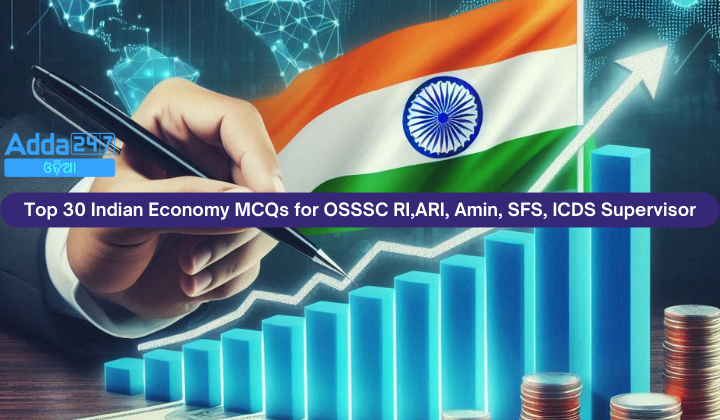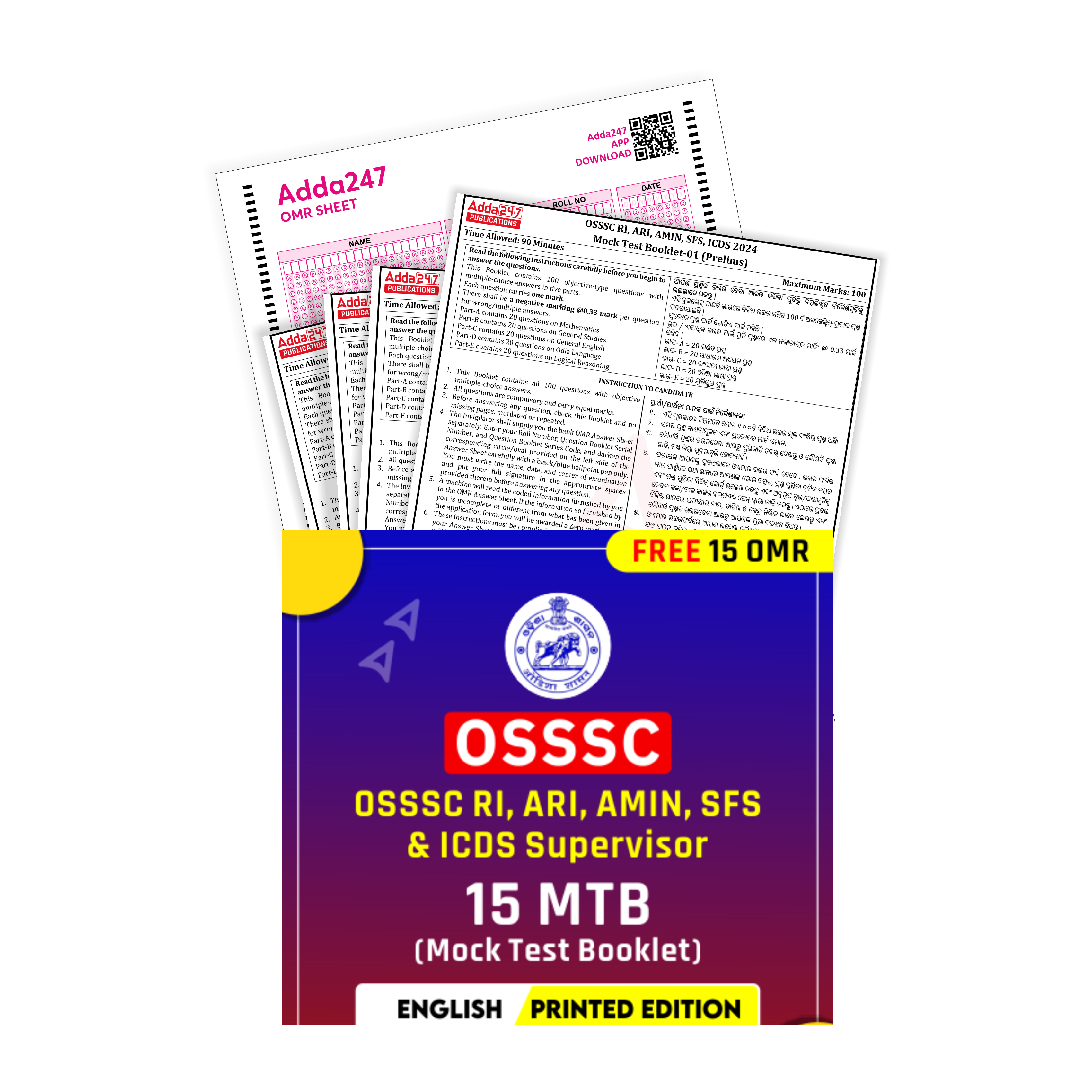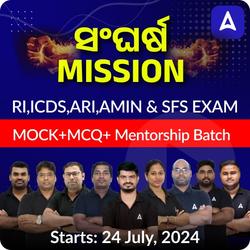Preparing for the OSSSC RI, ARI, Amin, SFS, and ICDS Supervisor exams requires a solid understanding of the Indian economy. These competitive exams often feature questions on economic concepts, policies, and current trends. A focused study of the top 30 multiple-choice questions (MCQs) can significantly enhance your readiness. These questions cover critical topics such as GDP growth, inflation, fiscal policy, banking reforms, and trade. They are tailored to align with the exam pattern, helping candidates gain a comprehensive overview and practice efficiently for their upcoming assessments.
Top 30 Indian Economy MCQs for OSSSC RI,ARI, Amin, SFS, ICDS Supervisor
- What was the GST collection amount in June 2024, and what was the year-on-year growth rate?
(a) Rs 1.74 trillion, 7.7%
(b) Rs 1.50 trillion, 8.5%
(c) Rs 1.60 trillion, 7.2%
(d) Rs 1.80 trillion, 6.8%
S1. Ans. (a) Rs 1.74 trillion, 7.7% - What was the core sector growth rate for May 2024?
(a) 6.3%
(b) 7.0%
(c) 5.5%
(d) 6.8%
S2. Ans. (a) 6.3% - How much did India’s exports total in June 2024, and what was the import amount for the same month?
(a) Exports: USD 65.47 billion, Imports: USD 73.47 billion
(b) Exports: USD 70.00 billion, Imports: USD 75.00 billion
(c) Exports: USD 62.00 billion, Imports: USD 70.00 billion
(d) Exports: USD 68.00 billion, Imports: USD 72.00 billion
S3. Ans. (a) Exports: USD 65.47 billion, Imports: USD 73.47 billion - What was the annual inflation rate for the Wholesale Price Index (WPI) in June 2024?
(a) 3.36%
(b) 3.50%
(c) 3.20%
(d) 3.10%
S4. Ans. (a) 3.36% - What is the IMF’s revised GDP growth forecast for India for 2024-25?
(a) 7%
(b) 6.5%
(c) 7.5%
(d) 6.8%
S5. Ans. (a) 7% - According to FICCI, what is the projected GDP growth rate for India in 2024-25?
(a) 7%
(b) 6.8%
(c) 7.2%
(d) 6.5%
S6. Ans. (a) 7% - What are the key figures outlined in the Union Budget 2024-25 for expenditure, receipts, and fiscal deficit?
(a) Expenditure: ₹48.21 lakh crore, Receipts: ₹32.07 lakh crore, Fiscal Deficit: 4.9%
(b) Expenditure: ₹50 lakh crore, Receipts: ₹30 lakh crore, Fiscal Deficit: 5%
(c) Expenditure: ₹45 lakh crore, Receipts: ₹33 lakh crore, Fiscal Deficit: 4.5%
(d) Expenditure: ₹47 lakh crore, Receipts: ₹31 lakh crore, Fiscal Deficit: 5.2%
S7. Ans. (a) Expenditure: ₹48.21 lakh crore, Receipts: ₹32.07 lakh crore, Fiscal Deficit: 4.9% - How much capital expenditure has been allocated to Indian Railways for the fiscal year 2024-25?
(a) Rs 2,62,200 crore
(b) Rs 2,50,000 crore
(c) Rs 2,75,000 crore
(d) Rs 2,60,000 crore
S8. Ans. (a) Rs 2,62,200 crore - What does NCAER project for India’s GDP growth in fiscal 2025?
(a) Over 7%
(b) 6.5%
(c) 7.2%
(d) 6.8%
S9. Ans. (a) Over 7% - What was the percentage increase in digital payments as of March 31, 2024, according to the RBI?
(a) 12.6%
(b) 10.5%
(c) 14.2%
(d) 11.8%
S10. Ans. (a) 12.6% - What is the most widely used tool of monetary policy?
(a) Issuing of notes
(b) Open market operations
(c) Discount rate
(d) None of these
Ans. (b)
Sol: Open market operations involve the buying and selling of government securities. They are flexible and thus the most frequently used tool of monetary policy. - What is the meaning of Repo Rate?
(a) When a bank is in need of cash it can discount bills of exchange and avail loan facilities from the Reserve Bank of India.
(b) When a bank has excess cash, they buy securities from RBI against cash on the condition that they resell the securities to RBI on a pre-fixed day and price
(c) It is the rate at which RBI allows temporary loan facilities to commercial banks against government securities on the condition that the bank will repurchase the securities within a short period.
(d) It is a rate that is offered by banks to their most valued customers or prime customers.
Ans. (c)
Sol: Repo rate is the rate at which the central bank of a country (Reserve Bank of India in the case of India) lends money to commercial banks in the event of any shortfall of funds. Repo rate is used by monetary authorities to control inflation. - When RBI does some open market operation transactions, it wishes to regulate which of the following?
(a) Inflation
(b) Supply of money in the economy
(c) Borrowing power of the commercial banks
(d) A & B
Ans. (d)
Sol: When the Central Bank wants to infuse liquidity into the monetary system, it buys government securities in the open market, providing liquidity to commercial banks. Conversely, selling securities curbs liquidity. Thus, the Central Bank indirectly controls the money supply and influences short-term interest rates. - When the cash reserve ratio (CRR) is increased by the RBI, it will:
(a) Increase the supply of money in the economy
(b) Decrease the supply of money in the economy
(c) No impact on the supply of money in the economy
(d) Initially increase the supply but later on decrease automatically
Ans. (b)
Sol: When RBI increases the CRR, fewer funds are available with banks as they have to keep larger portions of their cash with RBI. This leads to a decrease in the money supply. - Banking sector comes under which of the following sectors?
(a) Manufacturing sector
(b) Industrial sector
(c) Service sector
(d) None of these
Ans. (c)
Sol: The Service Sector, also called the tertiary sector, includes banking along with activities such as retail, education, and healthcare. - Open Market Operations means:
(a) Sale of agricultural products in the government regulated Mandis.
(b) Sale and purchase of bonds and securities to the commercial banks by the RBI.
(c) Sale and purchase of bonds and securities by the RBI to the government.
(d) Sale and purchase of bonds and securities by the commercial banks to the customers.
Ans. (b)
Sol: Open market operations (OMO) refer to the RBI buying and selling government securities to regulate the money supply in banks. - Which of the following is the recently opened bank in India?
(a) IDFC
(b) Bandhu
(c) Axis
(d) Gunjan
Ans. (a)
Sol: IDFC First Bank, headquartered in Mumbai, began operations on October 1, 2015. - BASEL NORMS are related to the:
(a) Insurance sector
(b) Telecommunication
(c) Real estate
(d) Banking sector
Ans. (d)
Sol: Basel norms, or Basel accords, are international banking regulations issued by the Basel Committee on Banking Supervision, aiming to strengthen the global banking system. - Which of the following is not a monetary tool?
(a) CRR
(b) SLR
(c) Deficit financing
(d) Open market operations
Ans. (c)
Sol: Deficit financing involves generating funds to cover a budget deficit, not a monetary policy tool. Monetary tools include CRR, SLR, and open market operations. - How much interest is paid by the RBI on the money deposited under the CRR measure?
(a) Equal to the rate of CRR
(b) More than the CRR
(c) Less than the CRR
(d) No interest is paid by the RBI
Ans. (d)
Sol: The RBI does not pay interest on the money deposited by banks under the CRR measure. - What option does the central government not include in the development expenditure?
(a) Grants to states
(b) Expenditure on social and community services
(c) Expenditure on economic services
(d) Defence expenditure
Sol. (d) - Which of the following defines depreciation?
(a) Destruction of a plant in a fire accident
(b) Loss of equipment over time due to wear and tear
(c) Closure of a plant due to labour trouble
(d) Closure of a plant due to lockout
Sol. (b) - Generally, deficit financing can create inflation. However, it can be checked if _________.
(a) government expenditure increases the aggregate supply in the aggregate demand ratio.
(b) all the investment is indicated as payment on national debt only.
(c) only the aggregate demand is increased.
(d) All of the above
Sol. (d) - With which of the following did the ARDC merge on 12 July, 1982?
(a) NABARD
(b) EXIM Bank
(c) RBI
(d) None of the above
Sol. (a) - What is the main cause of the export surplus?
(a) The country’s stringent import policy
(b) Developments in national and international markets
(c) The country’s exports promotion value
(d) None of the above
Sol. (b) - If RBI reduces the cash reserve ratio, what will happen to the credit creation?
(a) There will be no impact.
(b) It will decrease.
(c) It will increase.
(d) None of the above
Sol. (c) - Which option is not mentioned in a firm’s balance sheet?
(a) Cash held at the bank
(b) Revenue from sales of the company’s products
(c) Total issued capital
(d) Value of the stocks of raw materials held
Sol. (b) - Which of the following does the state financial corporation in the State Bank of India give special assistance to?
(a) Medium and small-scale industries
(b) Large-scale industries
(c) Cottage industry
(d) Agricultural farms
Sol. (a) - Which of the following are the central cooperative banks directly associated with?
(a) Central government
(b) Land development banks
(c) State cooperative banks
(d) Farmers
Sol. (c) - The first complete Indian Bank was established in which year?
(a) 1794
(b) 1894
(c) 1896
(d) 1902
Sol. (b)










